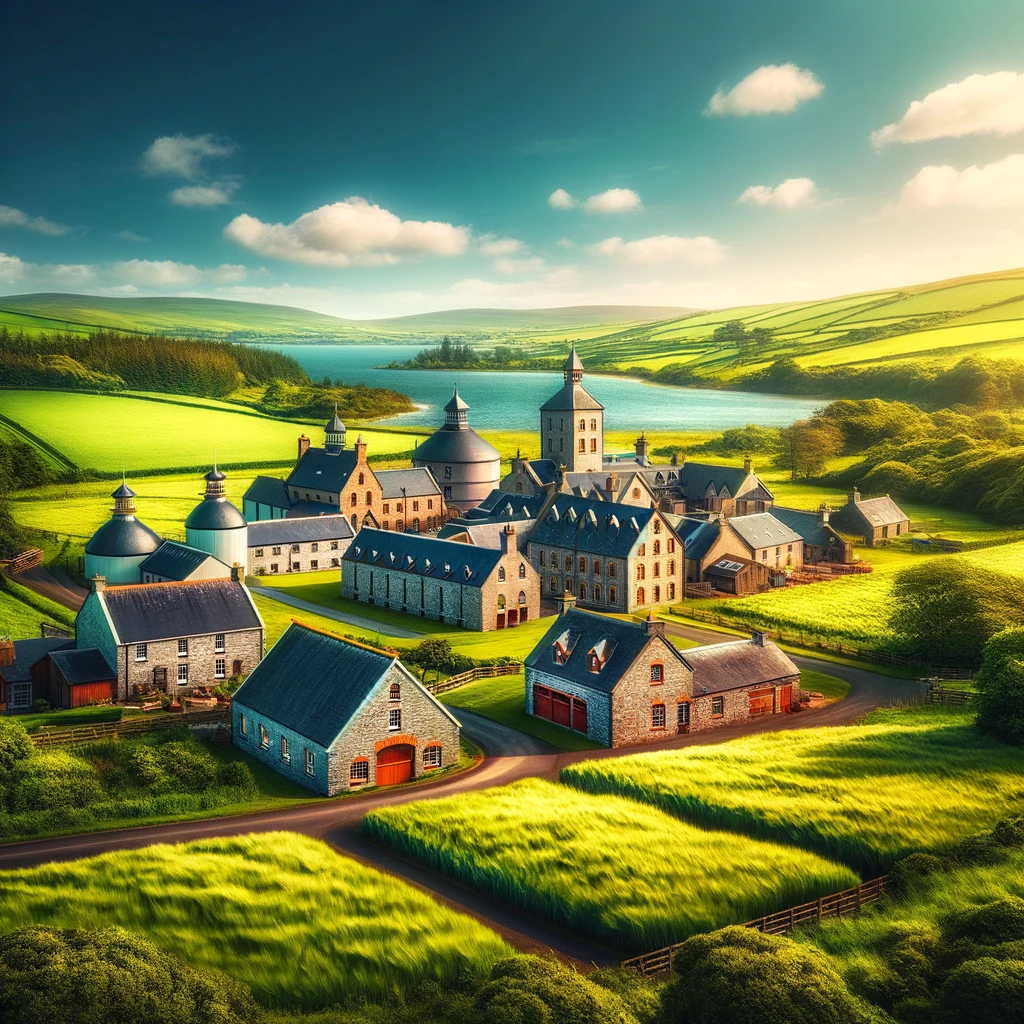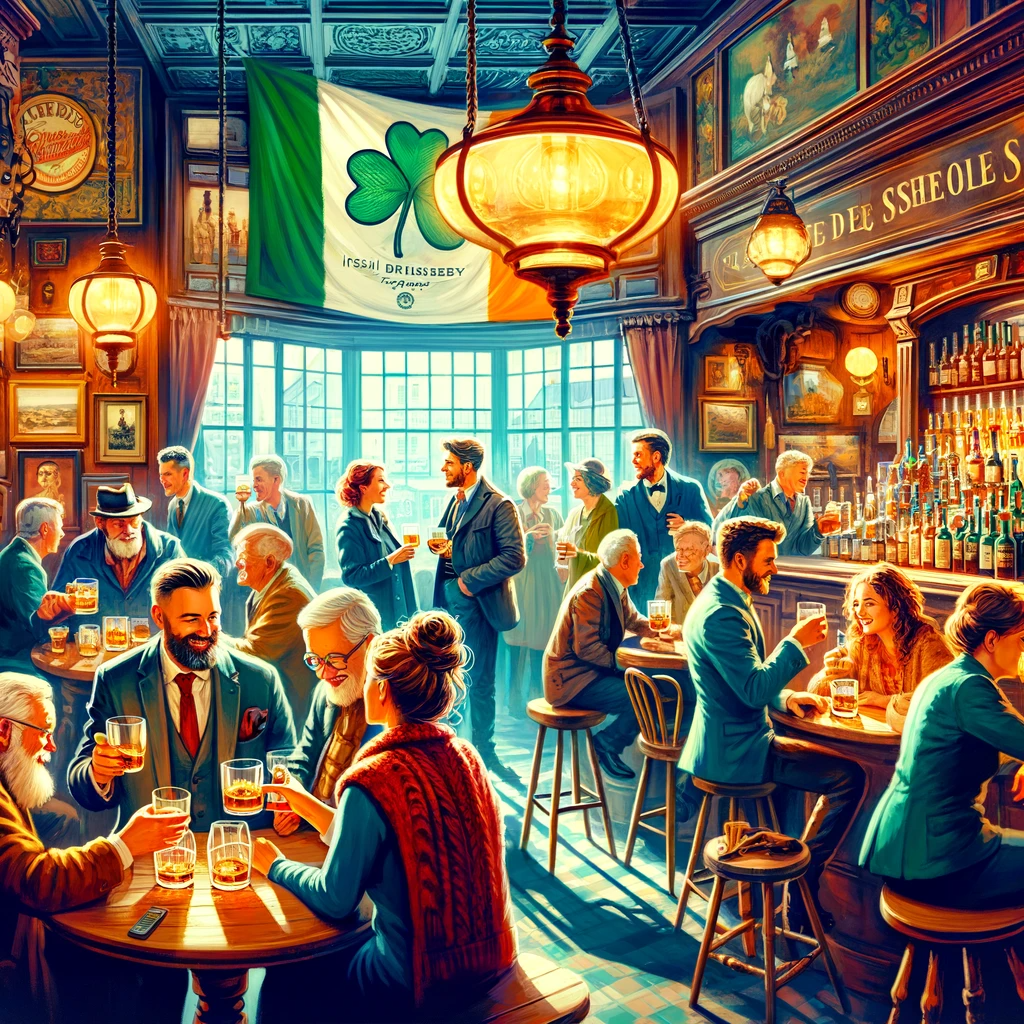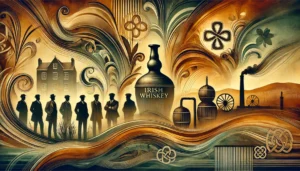Introduction
This will be a beginner’s guide that delves into the heart of Ireland’s most cherished spirit. Irish whiskey isn’t just a beverage; it’s a narrative woven into the very fabric of Ireland’s history and culture. From the misty hills of the Emerald Isle to the bustling pubs filled with music and camaraderie, Irish whiskey has been a symbol of Irish heritage, a testament to resilience, and a vehicle for storytelling.
In this journey, we explore the cultural significance of Irish whiskey, tracing its origins from ancient monastic traditions to its status as a global icon. We’ll discover how Irish whiskey has shaped, and been shaped by, the social, economic, and artistic facets of Irish life. From its historical roots, through periods of struggle and triumph, to its resurgence in the modern era, Irish whiskey stands as a proud representation of Ireland’s past and present.
As we unveil the story of Irish whiskey, we invite you to savour not just the taste, but the rich tapestry of tradition, innovation, and the indomitable spirit that makes Irish whiskey a timeless treasure. Join us in celebrating the craft, the culture, and the community that Irish whiskey embodies.
Irish Whiskey: A Cultural Icon – Exploring its Significance in Irish Heritage
Irish whiskey is much more than a sumptuous spirit; it’s a vibrant thread in the tapestry of Irish culture. Its story is a fascinating blend of history, tradition, and social evolution, deeply entwined with Ireland’s national identity.

Ancient Origins and Monastic Influence The tale of Irish whiskey begins over a thousand years ago, with its roots traceable to monastic settlements. These monasteries were not just religious hubs but centres of learning and innovation. The monks, skilled in the art of distillation, which they likely learned from their travels in the Mediterranean, created a unique distillate from barley. This spirit, known in Gaelic as “uisce beatha,” meaning “water of life,” was the precursor to what we now know as whiskey.
Whiskey and Social Fabric Throughout centuries, Irish whiskey evolved from a monastic treasure to a household staple. It was a warm comfort against the harsh Irish winters, a medicinal potion during times of illness, and a centrepiece at gatherings and celebrations. In rural Ireland, whiskey production was a family tradition, with recipes and methods passed down through generations.
Symbol of Resilience and Independence The history of Irish whiskey is also a narrative of resilience. Through periods of tumult, including British rule and the infamous temperance movement, Irish whiskey makers persevered. The spirit’s survival and growth during these times became a symbol of Irish tenacity and defiance. The 18th and 19th centuries marked the golden age of Irish whiskey, where it was renowned worldwide, symbolizing quality and craftsmanship.
Cultural Renaissance in Literature and Song Irish whiskey has been immortalized in Irish literature and folk songs, reflecting its significance in the cultural psyche. Legendary writers like James Joyce and W.B. Yeats have mentioned it in their works, showcasing its influence on Irish art and expression.
Whiskey’s Role in Modern Irish Society Today, Irish whiskey is experiencing a renaissance, enjoying renewed popularity and respect worldwide. It remains a proud emblem of Irish culture, symbolizing the nation’s rich history, enduring spirit, and a future filled with possibilities. Distilleries are not just production sites but cultural landmarks, offering tours that narrate the whiskey’s storied past, showcasing its deep connection to Irish heritage.
From Monks to Masses: The Historical Journey of Irish Whiskey – Understanding its Roots and Evolution
The story of Irish whiskey is as old as Ireland itself, intertwining with the nation’s history in profound ways. Its evolution from an ancient craft to a symbol of Irish spirit mirrors the transformation of Ireland.

Monastic Beginnings The earliest record of whiskey in Ireland dates back to the 12th century, with monasteries being the first distillers. Monks who returned from their travels brought back the art of distillation from the Middle East. Initially used for medicinal purposes, this “aqua vitae” quickly became an integral part of Irish life.
Distillation Goes Domestic As monasteries declined with the English Reformation, whiskey-making moved into the homes and farms of ordinary Irish people. It became customary for families to distil their own whiskey, a tradition that became deeply rooted in Irish society. This era marked the birth of numerous small distilleries, many of which would become the cornerstones of the modern Irish whiskey industry.
The Turbulent Times The 18th and 19th centuries were both a golden age and a period of strife for Irish whiskey. While it gained global acclaim, it also faced challenges like the “whiskey tax” of 1661 and competition from Scottish distillers. Despite these obstacles, Irish whiskey held its ground, with its unique pot still production method distinguishing it from other whiskies.
The Dark Era and Resurgence The 20th century brought severe trials for Irish whiskey, including Prohibition in the United States, Irish War of Independence, and trade wars with Britain. These events nearly decimated the industry. However, the late 20th century saw a resurgence, led by remaining distilleries and new entrants, rejuvenating the Irish whiskey market.
A Symbol of Irish Heritage Today, the story of Irish whiskey is not just about a drink; it’s a narrative of Irish resilience, innovation, and cultural identity. It’s a tale that continues to evolve, with each bottle carrying the legacy of centuries.
The Art of Whiskey Making in Ireland: Traditional Methods and Distinct Characteristics
Irish whiskey is celebrated not just for its rich history but also for its unique crafting process, which has been honed and perfected over centuries. This segment delves into the traditional methods and distinct characteristics that set Irish whiskey apart.

The Art of Malting and Mashing The process begins with malting, where barley grains are soaked in water and then allowed to germinate. This releases enzymes necessary for converting starches into fermentable sugars. After germination, the grains are dried in a kiln, often using peat, imparting a distinct smoky flavour. The malted barley is then mashed, mixed with water, and heated, further breaking down the starches into sugars.
Fermentation and Distillation The mash is cooled and transferred to fermentation vessels, typically wooden vats, where yeast is added. The yeast feeds on the sugars, producing alcohol and other compounds that contribute to flavour. After fermentation, the liquid, now known as ‘wash,’ contains low alcohol content. It’s then distilled, usually three times in Ireland, in pot stills. This triple distillation creates a smoother, lighter spirit compared to its counterparts.
Aging and Maturation The heart of the whiskey’s flavour development lies in its aging process. Irish whiskey must be aged for at least three years in wooden casks, which significantly influence its taste. These casks, often used bourbon or sherry barrels, impart complex flavours, from vanilla and caramel to fruit and spice notes. The interaction between the whiskey and the wood over time adds depth and character, making each batch unique.
Variety and Flavours Irish whiskey comes in several varieties, including single malt, single pot still, and blended whiskey, each with its own flavour profile. Single malt is made from 100% malted barley, offering a rich and smooth taste. Single pot still, unique to Ireland, combines malted and unmalted barley, giving a spicy and full-bodied flavour. Blended whiskey, a mix of malt and grain whiskies, provides a lighter and more approachable taste.
A Legacy of Craftsmanship The creation of Irish whiskey is a craft passed down through generations, a blend of science and art. Each distillery in Ireland, with its own methods and secrets, contributes to the diversity and richness of Irish whiskey. This craftsmanship, steeped in tradition yet embracing innovation, is what makes Irish whiskey a beloved spirit worldwide.
Irish Whiskey in Literature, Music, and Celebrations: A Symbol in Irish Cultural Expression
Irish whiskey isn’t just a drink; it’s a cultural icon, deeply embedded in various aspects of Irish life. Its presence in literature, music, and traditional celebrations highlights its integral role in Irish culture.

Whiskey in Irish Literature Irish whiskey has been a muse for many Irish writers, finding its way into the heart of Irish literature. James Joyce, in his seminal work “Ulysses,” pays homage to Irish whiskey, symbolizing its cultural importance. Writers like W.B. Yeats and Brendan Behan have also celebrated Irish whiskey in their works, showcasing its role in storytelling and as a catalyst for social interaction and reflection.
A Staple in Irish Music and Dance Traditional Irish music and dance sessions, often held in pubs, are incomplete without a glass of whiskey. These gatherings, where locals and visitors alike share stories and songs, are a testament to the communal spirit of the Irish. The warm, convivial atmosphere of a pub, with lively music and the clink of whiskey glasses, encapsulates the essence of Irish social life.
Celebrations and Toasts Irish whiskey is central to celebrations and significant life events. It’s a symbol of hospitality, shared during weddings, birthdays, and even funerals. A toast with Irish whiskey is more than a drink; it’s a gesture of goodwill, friendship, and shared history.
Whiskey Festivals and Tours Ireland hosts numerous whiskey festivals, drawing enthusiasts from around the world. These events are not just about tasting different whiskeys but also about celebrating Irish culture and heritage. Whiskey tours in distilleries offer a glimpse into the crafting process, connecting visitors with the rich history and tradition of Irish whiskey making.
Intertwining with Modern Culture As Ireland evolves, so does the role of whiskey in its culture. It remains a staple in modern Irish life, bridging the gap between the past and the present, and continues to inspire artists, musicians, and writers, reflecting the ever-changing yet enduring spirit of Ireland.
Irish Whiskey Today: Its Role in Modern Irish Society and Global Influence
Irish whiskey has not only retained its revered status in Irish culture but has also adapted to the changing times, witnessing a remarkable resurgence in the global market.

The Renaissance of Irish Whiskey The 21st century has been a golden era for Irish whiskey, marked by a phenomenal increase in global popularity. New distilleries have sprung up across Ireland, each bringing innovative techniques while respecting the age-old traditions of whiskey making. This blend of the old and the new has attracted a new generation of whiskey enthusiasts.
Innovation in Distillation and Flavour Contemporary Irish whiskey makers are experimenting with different grain types, distillation methods, and maturation processes to create unique flavour profiles. This innovation has led to a diverse range of Irish whiskeys, from classic blends to single malts with distinct characteristics.
Global Appeal and Recognition Irish whiskey’s rise in the global market is a testament to its quality and versatility. It’s now one of the fastest-growing spirit categories in the world, with exports reaching new heights. The spirit has gained recognition and appreciation from connoisseurs and casual drinkers alike, solidifying its place in the global spirits industry.
Cultural and Economic Impact The whiskey industry has become a significant contributor to Ireland’s economy, generating jobs and boosting tourism. Distilleries offer immersive experiences, allowing visitors to witness the magic of whiskey making and understand its cultural significance.
A Symbol of Irish Identity Irish whiskey, while enjoying global success, remains a proud emblem of Irish culture and heritage. It’s a symbol of Ireland’s history, craftsmanship, and the enduring spirit of its people. As it continues to evolve, Irish whiskey carries with it the legacy of centuries, a liquid chronicle of Ireland’s past, present, and future.
More Than Just A Spirit
Irish whiskey is more than just a spirit; it’s a living testament to Ireland’s rich history, vibrant culture, and indomitable spirit. From its humble beginnings in monastic distilleries to its current status as a global phenomenon, Irish whiskey has stood the test of time, evolving and adapting while staying true to its roots. It’s a story of resilience and innovation, of tradition and transformation.
As we’ve discovered, the essence of Irish whiskey extends far beyond the distillation process. It’s interwoven into the fabric of Irish life, capturing the heart of its people, their celebrations, literature, music, and even their struggles. Each sip of Irish whiskey is not just a taste of a finely crafted beverage but an immersive experience into a culture that has cherished and preserved this golden elixir through centuries.
In the modern era, as the world embraces the diversity and richness of Irish whiskey, Ireland continues to innovate while honouring its heritage. The spirit of Irish whiskey, much like the spirit of Ireland, is enduring and captivating, inviting us to explore its depths and celebrate its triumphs.
Whether you’re a whiskey aficionado or new to this world, the journey through the culture and craft of Irish whiskey is a journey through the heart of Ireland. It’s a journey that tells a story of a nation, its people, and their unyielding spirit, encapsulated in each bottle of this remarkable spirit.








Be First to Comment